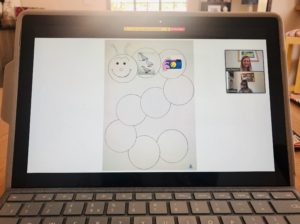-
What equipment do I need? Can I use a tablet/phone?
The app for Zoom (the video conferencing programme) can be downloaded on Windows and macOS and the mobile app is also available on Android and iOS, meaning it can be used on computers, laptops, tablets, iPads, iPhones and other smartphones. There are advantages to both computers and tablets/phones. We have found that phone screens are too small for therapy and assessments – but they can be used for observations and advice – and can be handy for little ones who find it difficult to keep still! Again tablets, are often useful where the child’s attention is reduced and so parents can move to keep the child interested and in view.
However, we have found laptops/computers easiest for sessions as the student has a place to sit and to focus. It also means that we can share videos and documents with you more easily and can even give you control of the screen so students can click and interact with on-screen tasks.
You will also need a reliable internet connection.
-
What if the technology goes wrong/fails on the day resulting in us not getting access to the session?
We highly recommend a ‘practice’ log in before your child’s first session to familiarise yourself with the Zoom layout. Please also test your camera, speakers and microphone before the session. In the case of an unpreventable technology issue, we may be able to rearrange the session for when the problem has been resolved.
-
Do I need to make an account with Zoom?
Yes, you will need to set up an account to use Zoom. This is free and easy to do on their website.
-
Do we need to use zoom? Can we use FaceTime/Skype/WhatsApp/House Party/Google Hangouts?
We will only be using Zoom as this meets the security levels needed for us to conduct online therapy sessions. Your therapist will have prepared the session for use on Zoom and so will likely be using interactive features that work best on this platform.
Your therapist may send you resources/games/picture cards to print and use during or in between teletherapy sessions. If you do not have a printer and the printed resources are needed, then we may be able to post these out to your home address.
-
What does the research say? Will teletherapy be as effective as face-to-face?
Published research studies have documented the efficacy of teletherapy and the Royal College of Speech and Language Therapists (our governing body) recognises the benefits of therapy delivered online. Many studies have found that the outcomes for students receiving teletherapy are equal to (and sometimes better) than the outcomes for the comparison group receiving face-to-face intervention (Kent State Uni, 2011; Wales et al., 2017; the MAYO clinic, 1997 to note a few).
-
Is teletherapy appropriate for my child?
Your therapist will be in contact with you to discuss whether your child would be a good candidate for teletherapy. On an individual basis, your therapist would consider your child’s age, needs/targets, attention levels and other individual circumstances that may impact their success with online sessions.
-
Can you carry out assessments via teletherapy?
Yes! Lots of our assessments can be delivered online and many formal SLT assessments have been adapted by the creators to be conducted via teleconferencing.
For any review assessments please contact your therapist. For any new referrals please fill in the form on our website:
-
How long will the session last?
Therapists will typically book in a 60 minute slot for the session but intervention with the child may be 45 minutes or less depending on your child’s attention levels. Our therapists like to have a bit of time at the end of the session to speak with parents, discuss any findings, give advice/strategies and handover any activities that can be done at home before the next session.
-
Can parents meet with you over teleconference or have a phone call before the session with the child?
Of course – we’re here to answer any questions you might have and understand that sometimes it is easier to talk without your child present. Contact your therapist to arrange this.
-
Do parents need to be present for sessions?
This can depend on the child. Some of our older, teenage students may be able to attend to and follow their teletherapy session independently.
However, for most students we highly recommend that a parent is present throughout the session. You might be needed to troubleshoot any technology issues – to make sure the camera, microphone and speakers are on and working well. You may be needed as our ‘hands’ on the other side of the screen to support your child in a task. You may be needed to help manage behaviours and help motivate your child. Your support is often vital to a successful therapy session.
Being present will also mean that you can see what it is that your child needs to work on and see how the resources are used and what you can do at home between sessions.

